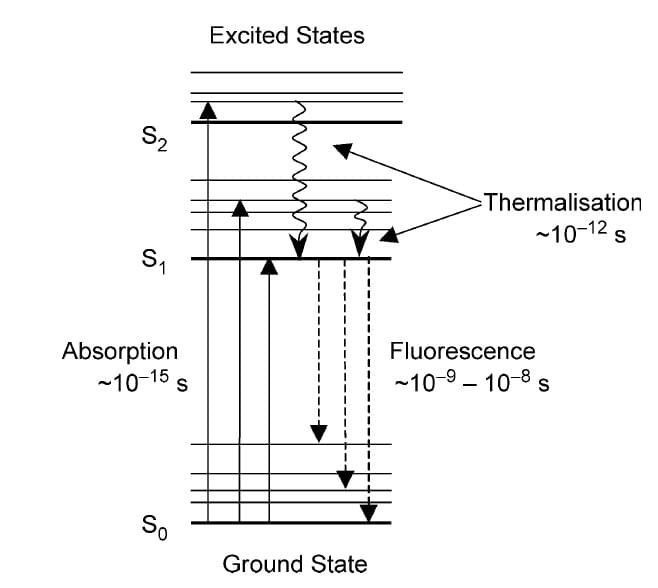Fluorometric Enzyme Assays
Creative Enzymes provides high-quality bioanalytical services and contract research specialized in enzyme activity analysis serving the needs of clients from the pharmaceutical, biotechnological and diagnostic industry. For years, Creative Enzymes has been the most experienced company in fluorometric enzyme assays. Our measurement capabilities are extensive, covering all kinds of enzymes including oxidoreductases, transferases, hydrolases, lyases, isomerases, and ligases. We always work closely with customers through the process of solving specific problems, operation optimization, and method development of enzymatic activity measurement.
Fluorescence is an emission phenomenon in which the wavelength of absorbed radiation is always lower (with higher energy) than the emitted (fluoresced) wavelength. Fluorometric enzyme assays use a difference in the fluorescence spectra of substrate from product to measure the enzyme reaction (Figure 1). Upon absorption of light, a fluorophore in the ground state (S0) is excited into higher energy singlet state levels. Rapid thermalization, which occurs in the picosecond timescale, leaves the excited molecule in the lowest vibrational level of the first excited state (S1). This excited singlet state can remain for a short time, in the order of nanoseconds, before the system decays back to the ground state upon emission of a photon. Since this excited to ground state transition is usually of lower energy than the excitation process, the emission is often at longer wavelengths than the excitation. This wavelength difference is known as the Stokes Shift. Virtually, all fluorescence data can be described by one of the five parameters: the excitation spectrum, the emission spectrum, the quantum yield, the fluorescence lifetime, and the anisotropy or polarization of the emission.
 Figure 1: Perrin-Jablonski diagram. S0 is the ground state while S1 and S2 are electronically excited states.
Figure 1: Perrin-Jablonski diagram. S0 is the ground state while S1 and S2 are electronically excited states.
Reference: Eccleston J F, Hutchinson J P, Jameson D M. Progress in medicinal chemistry, 2005, 43: 19-48.
Fluorometric assays are widely used for the determination of the kinetic mechanism of enzyme reactions, and are also used to configure kinetic assays for high throughput screening. To be measured with a fluorescence-based assay the reaction needs to proceed with either the formation of a fluorescent product from a nonfluorescent substrate or vice versa. An example of the first case is the use of the non-fluorescent butyl ester of resorufin as a substrate in a hydrolase assay, where enzymatic cleavage of the ester bond yields highly fluorescent resorufin. An example of the latter is any enzyme reaction involving the oxidation of NAD(P)H to the non-fluorescent NAD(P)+. Fluorescence resonance energy transfer (FRET) may also be exploited in enzyme assays where the enzymatic reaction changes the distance or orientation of the two fluorophores in the substrate, hence changing the observed fluorescence intensity of the donor or acceptor.
Fluorometric enzyme assays are generally much more sensitive than spectrophotometric assays, but can suffer from interference caused by impurities and the instability of many fluorescent compounds when exposed to light. The high sensitivities of the assays are particularly valuable in the current phase of increasing numbers of diagnostic enzyme estimations being performed on the small specimens of tissues, cells, or fluids typically available from human patients. Fluorometric assays also lend themselves specially to miniaturization of the reaction mixtures. In this way, further large increases in sensitivity can be achieved with a consequent decrease in demand for samples of enzyme and fluorogenic substrate. Conservation of the latter has become important with the advent of very expensive or scarce fluorogenic substrates.
With most up-to-date knowledge and advanced instrument, Creative Enzymes is fully confident to serve customers with reliable fluorometric enzyme assays, offering quantification of activity levels for all types of enzymes. By constantly striving for services of utmost quality, Creative Enzymes has earned the trust of tens of thousands of customers. Overall, Creative Enzymes is committed to achieving the highest grade of customers satisfaction and to improving services and quality management constantly.
Related Services
Enzymology Assays
Enzyme Activity Measurement